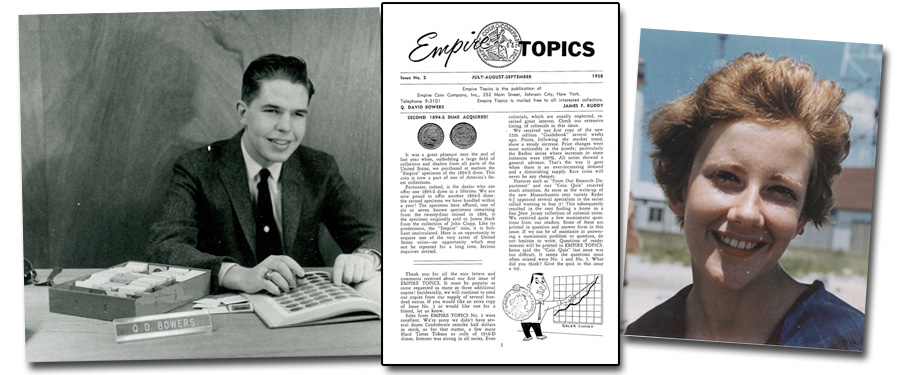
In 1958 and 1959 Darlene
Alvina Andersen, a classmate at Penn State, had a profound influence on my
life. A native of North Bergen, New Jersey, she had moved with her family a few
years before to Towanda, Pennsylvania, where she had been managing editor, then
editor of the high school paper, The Oriole, and a star student. Her
father, Hans Christian Frey-Anderson, had been involved in the maritime trade
and later was an executive with the Sylvania Company. Her parents divorced, and
her father remarried.
Later, she, her mother (who
had been a Rockette on the stage at Radio City Music Hall in the 1930s), and
two brothers, Wayne and Lyle, relocated to York, Pennsylvania. Her
mother joined the staff of P. Wiest & Sons Department Store, owned by the
Hydeman family. One of the Hydemans, Edwin, was quietly and privately forming a
great collection of rare coins, primarily through California dealer Abe Kosoff.
I don’t think the Andersen family knew anything about the coin collection, nor
did I until 1961 when Kosoff presented the Edwin Hydeman Collection at auction.
A very attractive and charming girl
with light red hair, Darlene was a journalism major. I had met her during
my sophomore year when roommate Joe Fuller brought her to visit our apartment.
At the time Joe, my other roommate David Brassington, and I would sing Good
Night Darlene to the tune of the famous hit song by The Weavers. Lots of
fun!
She, like most of us, was
contemplating various meanings of life. I discussed with her my contemplation
of the future. Seeing a connection, she gave me a copy of Ayn Rand’s The
Fountainhead, which she had just read. The protagonist, architect Howard
Roark, follows his own inner feelings, instead of succumbing to public opinion.
As I was soon to learn, Rand was famous for espousing the importance of the
individual over the conventional wisdom of society. Thoughts ran through my
mind that perhaps I should take heed and follow my own feelings. (Today as you
read this, the writings of Ann Rand are not politically correct, in the view of
many.) Rand’s We the Living also impressed me. Both Darlene and I found Atlas
Shrugged, which Rand considered her magnum opus, to be wordy
and full of philosophy to be interesting, but we were in the minority as the
book became very popular.
Not long thereafter,
Darlene read the latest issue of Empire Topics, the magazine I wrote and
edited for the Empire Coin Company. “That is so interesting,” she said.
“You are a very good writer!”
If ever there was a
“Eureka!” moment in my life that was it. Although I had decided to follow
professional numismatics, I had doubts about my abilities as an author. Now,
acting on her advice, I decided to jump in with both feet. For starters I
bought and read several books about journalism, style, and grammar. Afterward,
all sorts of writing projects ran through my mind. Mainly, I kept busy with our
catalogs, enjoying their creation more than ever.
I have many other nice
memories of Darlene, including automobile trips in central Pennsylvania to poke
around old iron furnaces and other interesting sites, dinners at the Corner
House and the Village Tavern, and more. We spent the 4th of July weekend in
1959 at Trout Manor, a boarding house, at Wildwood Crest on the New Jersey
shore, where, among other things, we visited an amusement park—then as now a
hobby interest—and drove down to Cape May to see the shore and all of the
Victorian buildings. The image of
Darlene featured here was taken by the author during this trip to the New
Jersey shore.
Darlene was married a few
years later, raised a family, and in 2015 passed away, mourned by all who knew
her.





